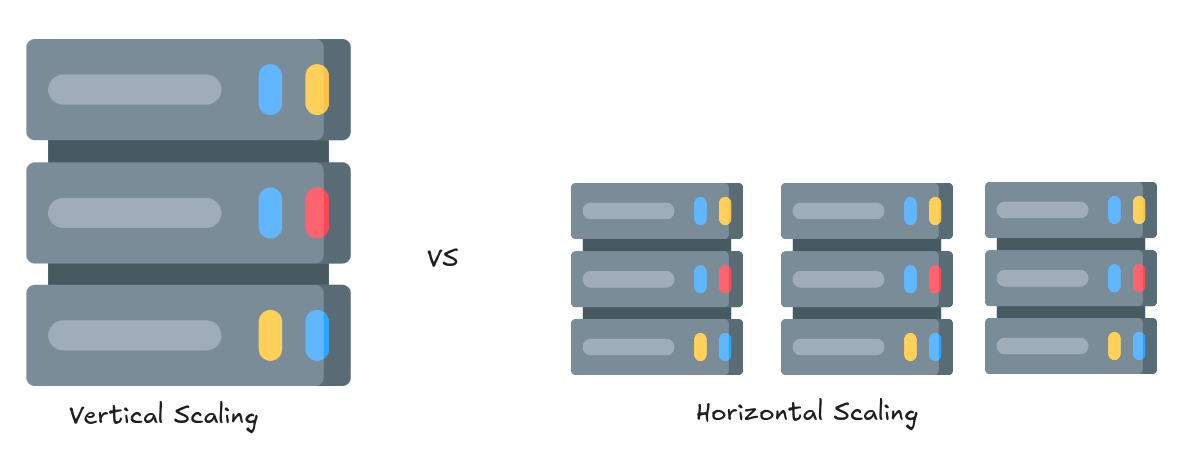Scaling is a crucial concept in system design, especially when we talk about modern software systems that serve millions of users daily. But what does scaling really mean? Why is it essential? And when do you choose vertical scaling over horizontal scaling? The answer is with in this post.
What is Scaling?
Scaling refers to the process of increasing a system's capacity to handle more load. This could mean accommodating more users, processing more transactions, or managing larger datasets. For instance, imagine an e-commerce app that experiences a surge in traffic during Black Friday sales. Without proper scaling, the app might slow down or even crash, resulting in a poor user experience and revenue loss.
In system design, scaling is often categorized into two types: vertical scaling and horizontal scaling. Let’s explore both in detail.
Vertical Scaling (Scaling Up)
Vertical scaling involves adding more power to an existing server, such as increasing its CPU, RAM, or storage capacity. For example, upgrading a server from 16GB RAM to 84GB is an instance of vertical scaling.
Pros:
Simplicity: It’s straightforward to implement since you’re working with a single server.
Ease of management: Maintaining one server is simpler than managing a distributed system.
Cons:
Hardware limits: You can only upgrade a server to a certain extent before hitting physical or cost limitations.
Downtime: Often requires taking the server offline during upgrades.
Single point of failure: If the server goes down, the entire system is affected.
Use Cases:
Vertical scaling is ideal for:
Monolithic applications.
Startups or smaller systems with low traffic and minimal scaling requirements.
Horizontal Scaling (Scaling Out)
Horizontal scaling involves adding more servers to distribute the load. Instead of relying on a single powerful server, you use multiple servers working together. For example, using ten medium-sized servers instead of one massive server.
Pros:
No hardware limits: You can keep adding servers as needed.
Fault tolerance: If one server fails, others can take over, ensuring high availability.
Better suited for distributed systems: Works well with microservices and modern architectures.
Cons:
Complexity: Requires additional infrastructure like load balancers and distributed databases.
Higher initial cost: Setting up a distributed system can be expensive.
Architectural planning: Needs significant effort to design and maintain.
Use Cases:
Horizontal scaling is essential for:
Large-scale systems like social media platforms and streaming services.
Applications that need high availability and fault tolerance.
Why or When Do You Need Scaling?
Scaling becomes critical for several reasons:
1. Growth
As your user base grows, your system must handle increased traffic, data, and transactions. For example, a payment gateway needs to process thousands of transactions per second without delays. However the issue of scaling only become an issue when your users base exceed the currently limit of your infrastructure.
2. Performance
Scaling ensures your application remains responsive even under heavy load. Think of as adjusting your system to perform or give similar performance when the user load was small.
3. Reliability
Horizontal scaling adds redundancy, so if one server fails, others can seamlessly take over, ensuring continuous service.
Real-Life Examples
Vertical Scaling:
A small local e-commerce app with minimal traffic can use a single, powerful server to handle its operations.
Horizontal Scaling:
Companies like Facebook, Amazon, and Netflix rely on horizontal scaling to manage millions of users and ensure their systems remain highly available.
Conclusion
Scaling is at the heart of building robust, high-performing, and reliable systems. Whether you choose vertical or horizontal scaling depends on your system’s requirements, budget, and long-term goals. Vertical scaling is great for simplicity and initial stages, while horizontal scaling is the go-to solution for large-scale, fault-tolerant systems.
So, which scaling strategy do you think fits your current project best? Share your thoughts in the comments or let me know your experiences with scaling in system design!
References
System Design Interview by Alex Xu
Designing Data-Intensive Applications by Martin Kleppmann
The Art of Scalability: Scalable Web Architecture, Processes, and Organizations for the Modern Enterprise by Martin L. Abbott and Michael T. Fisher
Site Reliability Engineering: How Google Runs Production Systems by Niall Richard Murphy, Betsy Beyer, Chris Jones, and Jennifer Petoff


